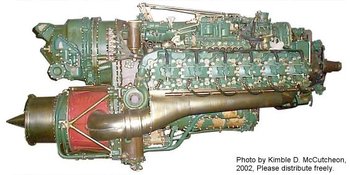Napier Nomad
|
|
The Nomad was a complex Diesel cycle aircraft engine from Napier & Son of the UK. The Nomad used a turbine to recover power from the exhaust of the otherwise conventional Diesel engine, resulting in a specific fuel consumption that remains unmatched today, 50 years later.
History
In 1945 the Air Ministry asked for proposals for a new 6,000 horsepower (4,500 kW) class engine with good economy. Curtiss-Wright was designing an engine of this sort of power known as the "turbo-compound", but Sir Harry Ricardo, one of Britain's great engine designers, suggested that the most economical combination would be a similar design using a diesel two-stroke in place of the Curtiss's gasoline engine.
Prior to World War II Napier had licensed the Junkers Jumo 204 Diesel design to set up production in the UK as the Napier Culverin, however the start of the war made the Sabre all-important and work on the Culverin was stopped. In response to the Air Ministry requirements they dusted off this work, combining two enlarged Culverin's into an H-block similar to the Sabre, resulting in a massive 75 litre design. Markets for an engine of this size seem limited however, and instead they returned to the original Culverin-like horizontally opposed 12 cylinder design, resulting in the Nomad.
Design
The Nomad design was increadibly complex, essentially two engines in one. One was a supercharged Diesel similar to the Culverin. Below this was a complete turboprop engine, based on their Naiad design. The output of the turboprop was geared to a shaft running inside the Diesel's, driving the front propeller of a contra-rotating pair. As if that were not enough, during takeoff additional fuel was dumped into the rear turbine stage for additional power, and turned off once the plane was cruising.
The compressor and turbine assemblies of the Nomad 1 were tested during 1948, and the complete unit was run in October 1949. The prototype was installed in the nose of a Avro Lincoln bomber for testing, and first flew in 1950. In total the Nomad 1 ran for just over 1,000 hours, and proved to be rather temperamental, but when running properly it could produce 3000 hp (2,200 kW) and 320 lbf (1.4 kN) thrust. It had a sfc of 0.36 lb/hp/hr.
Even before the Nomad 1 was running, its replacement, the Nomad 2, had already been designed. In this version an extra compressor stage was added, replacing the original supercharger. This stage was driven by an additional stage in the turbine, so the system was now more like a turbocharger and the compressed air for the Diesel was no longer "robbing" power. In addition the propeller shaft from the turbine was eliminated, and geared using a hydraulic clutch into the main shaft. The result was smaller and considerably simpler, a single engine driving a single propeller.
While the Nomad 2 was undergoing testing, a prototype Avro Shackleton was lent to Napier as a testbed. The engine proved bulky, like the Nomad 1 before it, and in the meantime several dummy engines were used on the Shackleton for various tests. By 1954 interest in the Nomad was dropping, and after the only other project based on it was cancelled, work on the engine was ended in April 1955, after an expenditure of £5.1 million.
Specifications
For Nomad 2:
- Layout: twelve-cylinder, two-row horizontally opposed
- Bore/Stroke/Displacement: (unknown)
- Compression ratio: (unknown)
- Power: 3,135 ehp (2,338 kW) max take-off
- Weight: 3,580 lb (1630 kg)
- SFC: 0.345 lb/hp.h (0.210 kg/kWh)
External links:
- The Nomad Proposal (http://www.home.aone.net.au/shack_one/nomad.htm)
|
Lists of Aircraft | Aircraft manufacturers | Aircraft engines | Aircraft engine manufacturers Airports | Airlines | Air forces | Aircraft weapons | Missiles | Timeline of aviation |

